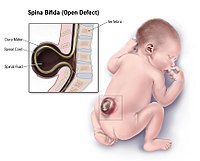
Photo from wikipedia
PURPOSE We sought to describe factors influencing reduced rates of obesity screening for patients with spinal cord injury (SCI) in the United States Veterans Health Administration (VA) and to foster… Click to show full abstract
PURPOSE We sought to describe factors influencing reduced rates of obesity screening for patients with spinal cord injury (SCI) in the United States Veterans Health Administration (VA) and to foster potential solutions. MATERIALS AND METHODS Semi-structured interviews with healthcare providers and patients with SCI who were recruited nationally from diverse VAs. We performed rapid qualitative analysis using content analysis of interview data. RESULTS There were 36 providers and 37 patients. We identified provider, patient, and system level barriers to obesity screening for individuals with SCI. Overarching barriers involved provider and patient perceptions that obesity screening is a low priority compared to other health conditions, and body mass index is of low utility. Other obesity screening barriers were related to measuring weight (i.e., insufficient equipment, unknown wheelchair weight, staffing shortages, measurement errors, reduced access to annual screening, insufficient time, patient preference not to be weighed) and measuring height (i.e., insufficient guidance and equipment to this population, measurement errors). CONCLUSIONS Barriers to obesity screenings exist for patients with SCI receiving care in VA. Healthcare provider and patient interviews suggest possible solutions, including standardizing height and weight measurement processes, ensuring equipment availability in clinics, clarifying guidelines, and offering support to providers and patients.IMPLICATIONS FOR REHABILITATIONIndividuals with spinal cord injury (SCI) have higher rates of obesity, but are often overlooked for annual obesity screening, even in clinic settings designed to care for individuals with SCI.Results may help tailor guidelines/education for healthcare and rehabilitation providers offering them guidance for improving obesity screening for individuals with SCI by standardizing weight and height measurement and documentation. To facilitate this, findings highlight the need for resources, such as ensuring clinics have necessary equipment, and increasing patient access to support and equipment.Improving the provision of obesity screening for individuals with SCI is necessary to improve health outcomes and patient satisfaction with care.
Journal Title: Disability and rehabilitation
Year Published: 2023
Link to full text (if available)
Share on Social Media: Sign Up to like & get
recommendations!